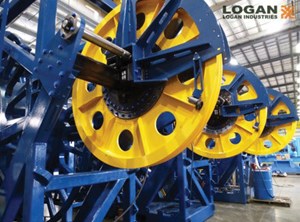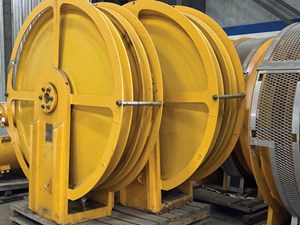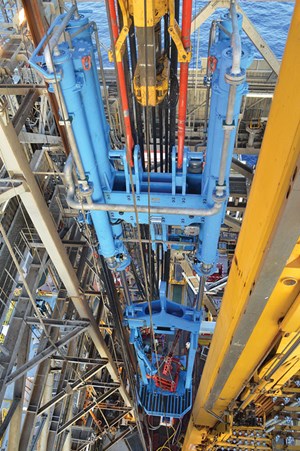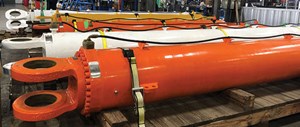Engineering for the long term
In the oilfield, providing insight to current problems and offering foresight into potential future problems should form the bedrock of client engagement. Engineers and technicians working on a clients’ machinery should treat it as if it were their own. True value is delivered through taking the time and effort to deeply consider the bigger picture of any project.
By operating as more than simply a repair shop, Logan Industries looks at the multitude of consequences inherent in making a variety of different machine design and engineering decisions. By fully considering an array of equipment performance scenarios, repair, manufacturing and rental companies have the potential to offer customized advice that is capable of saving their customers from repair jobs that would otherwise very likely occur several years (or in some cases a few short months) down the road. Not only does this approach make customers’ lives easier, it also cuts costs.
For example, offshore knuckle boom crane (KBC) cylinders are subjected to a harsh, sea air environment and their positioning is usually inaccessible. If a material had been chosen for the rod gland seal carrier, such as carbon steel, that does not sufficiently stand up to the corrosive effect of the salt air, it may prove impossible to take it apart to carry out an economical repair. Someone with the foresight five or ten years previously, to install a stainless steel gland that resists corrosion, would be saving the company thousands of dollars in replacement costs down the line. This type of long-term view is uncommon in the industry, as a short-term outlook often takes precedence, creating false expectations and cost structures.
TAKING THE LONG-TERM VIEW
Taking responsibility to fix issues before they cause problems later on is the most economical way of managing oilfield assets. Oilfield companies that are conscientious about forward planning and managing total cost of ownership of their assets will recognize that typically, cutting corners to save money in the short term on repairs will lead to bigger, more expensive problems that need to be fixed again down the road. Selecting cheap, substandard components guarantees that they will keep returning to the repair shop, accumulating hours of repair fees over their lifetime. A repair shop that actively engages with clients to clarify the bigger picture of their machine maintenance program will help to balance short-term budgets with long-term goals.
INGENUITY IN PRACTICE

Coiled tubing reelers. An operator approached Logan, saying they were interested in improving their overly cumbersome coiled tubing set-up on the deck of their drillship. The client offered Logan a design that encompassed how the large deck footprint issue could be solved. After analyzing and tweaking the design to improve efficiency further, Logan eventually constructed eight pairs of machines (Fig. 1) for the client’s support ship fleet that occupy a very small footprint on deck, allowing more room for the remainder of their equipment. This actually allowed them to tackle larger jobs because of this reduced footprint.
One of the major hurdles that needed to be overcome was the fatigue model for coiled tubing. Initially, the fatigue model design was based on the original wider spread of coiled tubing, including injector heads. The client, alongside the University of Tulsa’s Dr. Tipton, subsequently developed a fatigue model, based on the machinery that Logan built for this operator.
This model and corresponding results were presented at a petroleum engineering conference in 2017 (SPE paper 184750-MS). This case study highlighted how an inventive approach to machinery design can offer a client a significant competitive edge in their business. A seemingly minor change can go a long way in improving operations. In this case, it ultimately pioneered new ways of thinking about how to deploy and recover coiled tubing.
Knuckle boom crane cylinders. Knuckle boom cranes (KBCs) are the workhorses of the offshore industry, with nearly every platform and vessel using them in their day-to-day operations. However, the KBC cylinders that power them are often poorly fitted and overlooked. Unfortunately, if a cylinder on a large crane exhibits poor performance, or is unreliable, the whole machine becomes a liability for the owner’s operation. As a result, KBC cylinders frequently require repair, Fig. 2. Accordingly, Logan has developed a comprehensive understanding of their commonly misunderstood attributes.
Cylinders are often stored for long time durations, and seals occasionally do not perform well, when the cylinders are eventually taken out of storage and put into service. Accepted wisdom is that the cylinders need to be rotated frequently or stored vertically to keep them in good working order. In fact, issues with seals observed after a period of storage can often be attributed to poor wear band design and poor tolerances. If these two issues are designed properly, there is no need to rotate or store vertically.
Additionally, it is important to understand the environment in which the machinery is designed to perform and to choose the best chrome coating system to protect the rod substrate material and still provide a very hard and smooth surface for the seals to act against. Finally, seal packs perform an important role in the cylinder. If they do not work correctly, they can cause the entire cylinder to fail. To ensure this aspect of cylinder design is afforded the expertise it requires, Logan established long-term partnerships with a small number of world-renowned sealing experts, in order for them to contribute their sealing packages and bring expertise to bear with Logan.
Leveraging a multi-expert relationship, and making these suggestions for tweaks to the machinery during upgrades, can deliver a far more powerful and long-lasting engineering solution to the client.

Wireline riser tensioner cylinders. Due to sub-contracting design and manufacture elements, an OEM had inappropriately fitted wireline riser tensioner cylinders operating offshore with improperly sealed bearings. Eventually, the client operating these tensioners experienced persistent failures in the bearings in several of its drillships, due to loss of lubrication.
Logan was called in to help resolve these issues and spent several hours onsite, sketching creative solutions on a whiteboard. A novel solution was rapidly devised that included both Logan engineering and client input to not only resolve the loss of lubrication, but also apply proper preload to the new bearings, all in the same kit-type solution, Fig. 3. The client sent a sheave set over to Logan, which tweaked it to ease installation, and subsequently manufactured 60 sets supplying brand new bearings, covers and seals, pre-load caps, hardware, and a pulling device to extract the old ones and place new ones in a quick fashion.
Reduced bore direct acting tensioners (RB-DATS). A client observed, while using its direct-acting tensioners (DATS) in shallow waters, that they would exhibit lag and be less responsive than they should be. They were certainly less responsive than when used in deeper waters, which is where they have been designed to be used.
Logan hypothesized that cutting down the amount of fluid that sloshed back and forth within the DAT between the corresponding accumulator would reduce the lag. After employing some complex engineering expertise, an existing deepwater DAT was made suitable for shallow waters, using the existing rod and barrel, external footprint and interface points, while maintaining the same pressure rating and tuning the operating characteristics from deep water to shallow water. Quite a mouthful, but in simple terms, Logan adapted a deepwater tensioning device for use in shallow waters without changing the interface points.
A sub-arc welding machine and precision barrel positioners were used to manufacture the equivalent of reduced-bore direct-acting tensioner barrels, and these barrels were inserted (becoming reduced-bore sleeves) into the existing DAT to effectively reduce tensioning forces between the marine riser and subsea wellhead. This improved the operational performance of the DAT in shallow waters with lighter loads.
Logan was able to provide an operator with a DAT that looked the same, but it provided better operational performance in shallow water. This approach saved the client full replacement costs, while accommodating their existing interface points and control lines. An option was provided to the operator that was not readily available, and they were offered the ability to convert and un-convert when their water depths changed for different well locations. This provided a huge cost-saving for DAT owners, giving the drilling contractors more flexibility in where they can operate, in both shallow and deep waters.

Compensated coiled tubing lift frames. Eight years ago, Logan was repairing a Compensated Coiled Tubing Lift Frames (CCTLF) unit for a major operator, Fig. 4. Due to our experience in hydraulic machinery, the repairs were completed successfully despite us being previously unfamiliar with the machine. Subsequently, the operator asked us to build an original CCTLF, based on their observations of the company’s ingenuity during the repair.
During a dinner meeting with the major operator, Logan’s engineering team began sketching novel design ideas on a cocktail napkin, which resulted in a unique design that would save room in the derrick and ultimately improve the speed and safety of working operations for the operator. The cocktail napkin sketch resulted in the manufacture and sale of two units, which worked successfully in the field.
When our tenure in the field came to an end, we purchased them back and sold them to others, and built two more compensating units of the same design and several more non-compensating units for additional operators and contractors interested in improving their operations, many of which are still in use today. These units are the best in class, still operating today.
Catwalk kicker cylinders. On a land rig, the traditional way of getting the pipe from the ground to the drill floor, which is typically elevated to about 30 ft high, was to throw a chain around it and then hoist it up with a winch. A safer, more modern approach is to use a hydraulic catwalk machine to perform this work, which is approximately 80 ft long by about 12 ft wide.
Catwalk kickers are small, cylinder-actuated levers that “kick” the pipe out of the trough to eject the pipe onto the pipe racks when the drilling crew is tripping out of the hole and laying down pipe. The design of the catwalk is such that if there is even marginal misalignment due to imperfections in the location pad the catwalk is installed on, the kickers may not have enough stroke to perform the “kick” action completely.
When this happens, the pipe does not eject, and operations stop until the pipe is cleared, requiring a person to perform the pipe “kick” manually. Typically, the entire catwalk machine must be shut down before the crew member can approach it, due to safety requirements, costing valuable downtime for the whole operation.
Logan developed an innovative new cylinder design to serve as a drop-in replacement for what existed before, but with more stroke and a design that would work correctly every time, without exception. The drilling crew and the rig became far more efficient, as they could trip pipe faster in a set amount of time. The technique has now been patented and offered to all of the West Texas drilling crews that we service to make them more efficient.
THE VALUE OF INSIGHT AND FORESIGHT
Of course, it is vital that an equipment manufacturer and repair shop, such as ours, provides exceptional quality of repairs and is capable of delivering what the client asks for. But companies such as Logan offer even more value when they eschew a purely transactional relationship with clients and instead actively work toward offering solutions that lower the risk in their clients’ businesses; helping them to work better, more efficiently, and more economically than ever before. This type of big picture thinking is part-and-parcel with the way that we do business. This additional offering is not charged as an added cost, as it is considered by Logan as “the right thing to do.”
The total cost of ownership of essential components in an operators’ inventory should be properly understood and closely managed. When businesses start to improve their total cost of ownership, the whole industry benefits.
- Coiled tubing drilling’s role in the energy transition (March 2024)
- What's new in production (February 2024)
- Using data to create new completion efficiencies (February 2024)
- Digital tool kit enhances real-time decision-making to improve drilling efficiency and performance (February 2024)
- E&P outside the U.S. maintains a disciplined pace (February 2024)
- U.S. operators reduce activity as crude prices plunge (February 2024)



